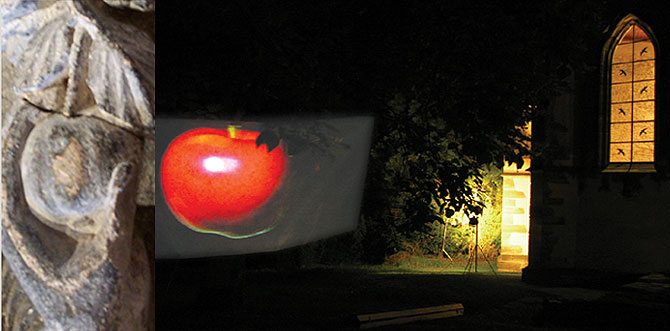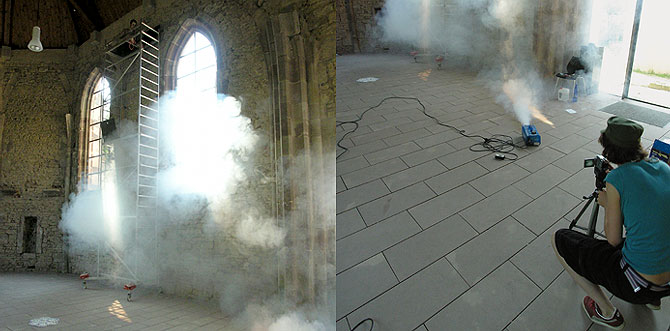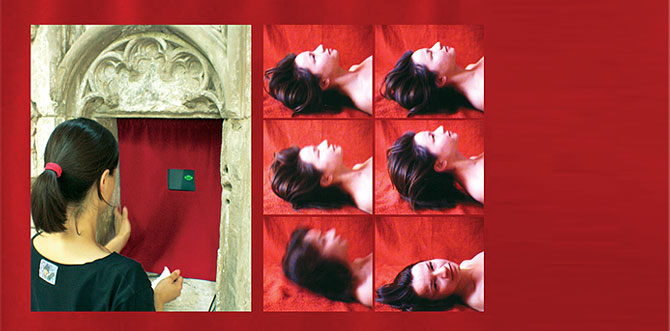6
summer – aestas
Individual and collective paradises

For each person, paradise is a different place, a different idea, a different image. The sacred spaces of Christianity are sites of an otherworldly expectation of paradise that is collectively determined by pictorial traditions and yet individually shaped.
14 students of the Hochschule der Bildenden Künste Saar under the direction of Prof. Daniel Hausig and the media artist Claudia Brieske took the cultural site Wintringer Chapel as an opportunity to develop artistic formulations on the theme of "Individual and Collective Paradises" in the summer semester 2005. The connection to the university class of Prof. Daniel Hausig arose on the recommendation of the Saarland writer and cultural journalist Dr. Sabine Graf.

Based on the guiding concept developed for the cultural site, the workshop participants had dealt with the building in advance in a project seminar, which was scientifically accompanied by the art historian Dr. Andreas Bayer, and developed situational working approaches for the site and its surroundings.
The final realization of the different working approaches took place within a one-week camp from July 10-17, 2005 directly on site at the Wintringer Chapel. Sleeping place was a tent camp on the pasture in the yard area. The chapel, its surroundings and areas of the farm buildings became studios.
The workshop focused on the question of locating a contemporary art in the context of the sacred building and the Wintringer farm, which is currently run as an organic farm by Lebenshilfe für Menschen mit Behinderung Obere Saar e.V.. In this context, the visual arts opened up new perspectives on the historical site for the artist group. Different aspects of a former medieval priory of the abbey of Wadgassen were thematized with different media. (Prof. Daniel Hausig, Claudia Brieske)
At the end of the workshop, the results of the work were presented to the public at a summer festival at the chapel.
On view until late into the night was an impressive exhibition of sculptural objects, video and sound installations as well as performances, photographs and drawings. The following pages outline the conceptual, methodological and associative thoughts of the artists and, in retrospect, once again allow an insight into the exhibition "Individual and Collective Paradises".
Participants Ingo Bracke, Nathalie Cordier, Julia Glucharen, Barbara Herold, Mark Heydrich, Birgit Hower, Marcus Michael Käubler, Ireen Köpke, Dragana Pesic, Stefanie Quade, Denise Ritter, Margit Schäfer, Susanne Schorr, Nikolaus Schrot, Véronique Verdet

Apple Fields, Room_Floor_Apple_Installation
(Apples of different varieties and colorings in the greenhouse on the planting tables: Two color fields of 7 x 7 = 49 apples each at the chapel in the course of the foundation walls: row in the width of four apples).
In his floor installation, Ingo Bracke explores the contextual meaning of the apple: The Wintringer farm foundation is today managed as a biologically oriented agricultural enterprise, where apples were already cultivated in the Middle Ages. In the area of the greenhouses, the connotation of the apple as a healthy food predominates. In the area around the chapel, the symbolic content of the forbidden fruit from the biblical creation myth comes more to the fore.

My bed is my paradise
(room installation in the barn of the Wintringer farm)
I see the concept of paradise as such detached from the religious context. The sum of all individual paradises results for me in the collective paradise. Eleven video statements on the subject of individual paradises.

The sky blue
is reflected in the debris of past lives, making the place a celestial and those whose bodies of stone for limited eternity there tell of forgotten longing.


Untitled
Video 3:27 min Loop DV PAL
In my investigations, I allowed spatial boundaries to be broken through, immaterial things to materialize. I confronted man, whether individually or collectively, with his own limits and challenged him to act vociferously until he would become aware of paradise as a reward for his successful efforts.

"The Nest"
(Installation in the interior of the chapel)
My concern was the play with, at first glance, inconspicuous materials, which through a theme, a title, a statement that puts itself in the room again and is put in a different light.

wintringer cape

The apple in the dark
The video installation thematizes possession and availability as the basis of individual and collective paradises. The image of desire is greater than the fetish itself.

Paradise tree
(Installation on the outside wall of the chapel)
Cables and loudspeakers form a tree from which the voices of various birds can be heard. While the outer wall closes off the sacred space, the installation removes the separation between inside and outside. Paradise becomes audible and unlimited. Two CD players, two amplifiers, copper cables and loudspeakers.

(Installation in the interior of the chapel)
I scratch the surface of people to see behind the facade and get to their innermost. The soul life expressed through emotionally charged faces.

7 sins
The basis of the sound installation is a composition of the diverse sounds/noises that arise when one eats an apple slowly and with relish. (Crunching, biting, chewing). The loudspeakers stand on seven wooden pedestals, each of which bears a small plate with information about the picking and eating ripeness as well as the taste and shape of different, regionally typical apple varieties.

Sugar baby
(foam sugar beans/dolls on stone floor)
In memory of the buried newborns inside the chapel and the unknown and unbaptized children outside, Margit Schäfer laid out two rosettes that grew from the east wall into the altar area. The two rosettes were composed of innumerable small foam sugar dolls, which are given away on the occasion of the baptism of children in the local region.

Underwaterworld
(video installation)
Like a modern stream of pilgrims, tourists are guided on a treadmill through an underwater tunnel made of acrylic glass beneath the sea. This video recording, taken in 2004 in the vacation paradise of Sentosa/Singapore by Margit Schäfer, was projected from outside onto the bricked-up west portal of the chapel. In the dark, it seemed as if all these people were slowly moving through the bricked-up portal into the interior.

Free Fall of Man
(Video installation in the former sacrament niche in the chapel. Duration: 1'44 (looped))
A woman falls. She falls again and again. At the end, she looks directly at the viewer.

Atmospheric video installaTion
Projections of moving water on three parallel hanging fabric panels. The space is physically changed by the installation and immersed in a calming mood. My goal is to influence the place, but also to work with it, so that the viewer feels at ease in the artificially created atmosphere. The blue coloring of the video footage and the meditative movement of the water played as loops create a completely new perception of the space.

Greenhouse
(green and red sprayed speakers, digital sound collage)
The sound cultures are digitally post-processed recordings of effervescent tablets, drops of water, screams of an obstetric toad, and various other soundscapes. The result suggests the growth of alien plants. Do paradisiacal flowers thrive here?
